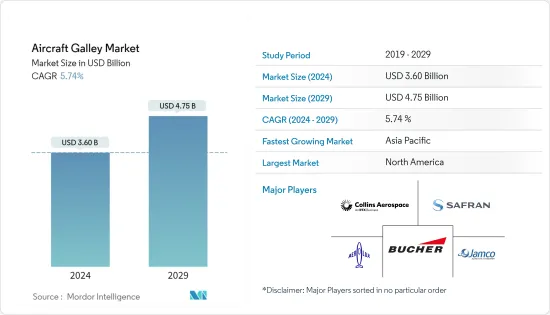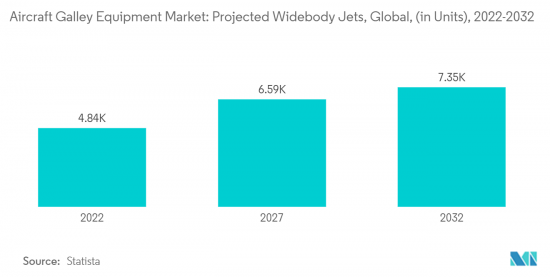
항공기 갤리 시장 규모는 2024년 36억 달러로 추정되며, 2029년 47억 5,000만 달러에 이를 것으로 예측되며, 예측 기간 중(2024-2029년) CAGR은 5.74%로 성장할 전망입니다.

항공기 갤리는 객실 승무원이 승객에게 제공하는 서비스를 홍보하는 데 매우 중요합니다. 항공기 갤리는 비행 중에 항공기 승객에게 제공되는 식사 옵션이 많다는 점에서 항공사의 비행 경험을 크게 향상시킵니다. 승객의 요구에 대응하고, 기내 서비스를 제공하고, 항공기 내의 공간을 효율적으로 이용할 필요성이, 갤리 채용의 촉진요인이 되고 있습니다. 항공 운송이 주요 운송 수단이 됨으로써 기내식 및 음료와 같은 기내 서비스에 대한 수요가 갤리 설치로 이어졌습니다. 항공사는 이러한 기내 서비스를 제공하는 것이 경제적으로 유익하며 승객 만족도에 기여하고 추가 수익을 가져올 수 있음을 인식했습니다.
저렴한 항공사(LCC) 모델은 제한된 서비스를 유료로 제공하는 반면 기내 승객 수를 늘리는 데 중점을 둡니다. LCC 세계 시장 침투가 진행됨에 따라 항공기 내의 공간 제약에 적응하기 위한 설계 과제가 생겨, 주방 설계자는 주방 기기의 소형화 및 경량화를 강요하고 있습니다. 기술과 설계의 복잡성은 항공기 갤리 시장의 제조 업체들에게 일정한 과제가 되고 있습니다. 데이터 분석 및 자동화를 이용하여 케이터링 업무를 최적화하는 스마트 갤리 솔루션의 채용 등 항공기 갤리에는 최첨단 기술이 통합되어 있습니다. 특히 이러한 기술은 항공사가 재고를 효과적으로 관리하고 식품 폐기를 줄이고 여객 경험을 향상시키는 데 도움이 될 수 있습니다.
항공 여객 수송량이 증가함에 따라 많은 항공사들이 기체 규모의 확대 및 기존 항공기의 현대화를 추진하고 있습니다. 세계 항공 여객 수가 증가함에 따라 장거리 항공편 수요가 증가했습니다. 쌍통로형 항공기는 이러한 장거리 노선을 효율적으로 커버하도록 설계되었으며, 높은 승객 정원과 편안함을 제공합니다. 또한 비즈니스 클래스 및 퍼스트 클래스와 같은 프리미엄 캐빈에도 넓은 레이아웃의 쌍통로가 선호되며, 항공사는 일류 서비스 및 편의 시설을 제공할 수 있습니다. 이 항공기에 설치된 갤리는 승객의 다양한 식품 및 음료의 취향에 부응하기 위해 활용됩니다. 따라서 최신 갤리에는 에스프레소 머신이나 와인칠러 인서트 등 고급형 설비가 여러 개 설치되어 있습니다. 항공사는 차별화된 서비스를 시장에서의 존재감 및 브랜드 이미지를 높이는 수단으로 인식하고 있기 때문에 신세대 항공기 조달은 항공기 주방의 통합을 촉진하여 항공기 주방 시장의 사업 전망을 밀어 올릴 것으로 보입니다.

아시아태평양의 개발도상국에서의 견조한 경제 성장, 양호한 인구, 인구동태가 이 지역의 항공 여객 수송을 견인하고 있습니다. 이 지역에서는 지난 10년간 항공 여객 운송량이 대폭 증가했지만, 그 주된 이유는 이 지역의 관광지와 항공 여행에 대한 접근성에 있어 예측 기간 동안에도 이 경향은 계속될 것으로 예상됩니다. 보잉의 Commercial Market Outlook에 따르면 중국은 2040년까지 민간 항공기 납품 총수의 20%를 차지할 것으로 예상됩니다. 에어버스에 따르면 이 지역의 평균 여객수가 전년대비 5.3% 증가했기 때문에 2040년까지 17,600대 이상의 신형 항공기가 필요합니다. 2027년까지 중국은 항공 운송량으로 세계 최대의 항공 시장이 될 것으로 예측되고 인도는 세계 3위 항공 시장으로 발전할 것으로 예측되며 인도네시아, 태국 등 다른 국가들은 세계 시장의 톱 10에 들어갈 것으로 예상됩니다. 이러한 좋은 동향은 이 지역에서 항공기 갤리 수요를 촉진할 것으로 예상됩니다. 이러한 예측은 항공기 OEM 각사가 이 지역에서의 발자취를 강화하는 데 주안을 두도록 촉구하고 있습니다.
항공기 갤리 시장은 세계 수준에서 사업을 전개하는 지배적인 공급업체가 제한되어 반고체화되었습니다. 시장 경쟁은 치열하고 각 회사가 가장 큰 시장 점유율을 얻으려고 경쟁하고 있습니다. 항공기 주방의 설계 및 무게와 관련된 제약과 거시경제적 요인으로 인한 항공기 주문 취소는 시장 성장을 방해합니다. 공급업체는 치열한 시장 경쟁에서 살아남기 위해 항공기 OEM에 고급 시스템을 제공해야 합니다. 시장을 독점하는 것은 Aerolux Ltd, JAMCO Corporation, Collins Aerospace(RTX Corporation), Safran, Bucher Leichtbau AG 등입니다. 이 기업은 주로 자사 제조 능력, 세계적인 거점 네트워크, 제품 제공, 연구개발 투자, 강력한 고객 기반을 바탕으로 경쟁하고 있습니다.

The Aircraft Galley Market size is estimated at USD 3.60 billion in 2024, and is expected to reach USD 4.75 billion by 2029, growing at a CAGR of 5.74% during the forecast period (2024-2029).
An aircraft galley is crucial for facilitating the services offered to the passengers by the cabin crew. Aircraft galleys significantly enhance the airline's flight experience in terms of the plethora of meal options served to the onboard passengers during a flight. The need to keep up with passenger needs, provision of inflight services, and efficient use of space on aircraft is a driving factor for the adoption of galleys. The demand for onboard services such as meals and beverages has led to the installation of galleys as air transport became a major mode of transport. Airlines recognized that offering these onboard services would be economically beneficial, contributing to passenger satisfaction and potentially bringing additional revenues.
The low-cost carrier (LCC) model focuses on increasing the number of onboard passengers while providing limited services as pay-per-demand. The increasing global market penetration of LCCs has resulted in design challenges to adjust to space constraints inside an aircraft, forcing the galley designers to reduce the size and weight of the galley equipment. Technological and design complexity are certain challenges for the manufacturers of the aircraft galley market. The integration of cutting-edge technology in aircraft galleys, such as the adoption of smart galley solutions that use data analytics and automation to optimize catering operations. In particular, such technologies may help airlines manage their inventories effectively, reduce food waste, and enhance the passenger experience.
This heightened air passenger traffic prompted numerous airlines to expand their fleet sizes and modernize their existing aircraft. With the increased global air passenger traffic, the demand for long-haul flights increased. Twin-aisle aircraft are designed to cover these extended routes efficiently, offering higher passenger capacity and comfort. Twin-aisle aircraft are also preferred for premium cabins, such as business and first class, due to their spacious layouts, allowing airlines to provide top-notch services and amenities. Galleys installed onboard these aircraft are utilized to cater to the passengers' wide range of food and drink preferences. Hence, the inserts of a modern galley include several luxurious types of equipment, such as espresso machines and wine chiller inserts. Since airlines perceive differentiated service as a means to enhance their market presence and brand image, the procurement of new-generation aircraft would drive the integration of aircraft galleys, thereby driving the business prospects of the aircraft galley market. For instance, in 2022, Boeing received 213 orders for widebodies. In June 2023, Air India ordered 70 widebody planes, comprising 34 A350-1000s and six A350-900s from Airbus, 20 B787 Dreamliners, and 10 B777Xs from Boeing. These scheduled orders are anticipated to bolster the growth of aircraft galley in twin-aisle aircraft.

The robust economic growth, favorable population, and demographic profiles of the populace in developing countries in the Asia-Pacific region are driving the air passenger traffic in the region. The region has seen a significant increase in air passenger traffic during the past decade, mostly due to the tourist destinations in the region and the ease of access to air travel, which is expected to continue during the forecast period. According to Boeing Commercial Market Outlook, China is expected to account for 20% of the total commercial aircraft deliveries by 2040. As per Airbus, the region will require more than 17,600 new aircraft by 2040, given the average 5.3% YoY passenger growth in the region. By 2027, China is forecasted to become the world's largest aviation market in terms of air traffic, and India is forecasted to develop into the world's third-largest aviation market, while other countries, such as Indonesia and Thailand, are forecasted to enter the top 10 global markets. Such favorable trends are anticipated to drive the demand for aircraft galleys in the region. These projections have encouraged aircraft OEMs to primarily focus on enhancing their footprint in the region. For instance, Embraer has planned to increase its aircraft deliveries to 100 per year due to an increase in orders from China and India. The company laid out the groundwork to deliver planes to China, as in November 2022, Embraer's E2 series, the E190-E2 commercial jets, received design certification approval from the Chinese Authorities.
The aircraft galley market is semi-consolidated due to the presence of a limited number of dominant vendors operating at a global level. The market is highly competitive, with players competing to gain the largest market share. Constraints associated with the design and weight of aircraft galley and cancellation of aircraft orders due to macroeconomic factors impede the growth of the market. Vendors must provide advanced systems to aircraft OEMs to survive in an intensely competitive market environment. The dominant market players include Aerolux Ltd, JAMCO Corporation, Collins Aerospace (RTX Corporation), Safran, and Bucher Leichtbau AG. These players mainly compete based on their in-house manufacturing capabilities, global footprint network, product offerings, R&D investments, and strong client base. For instance, In August 2021, Safran launched the MaxFlex galley for the Boeing 737 family. MaxFlex galley provides maximum flexibility, infinite combinations, and easy maintenance. More than 2,000 MaxFlex galleys are installed in the aircraft. Safran also offers SpaceFlex V2 Galley for Airbus A320/A321 aircraft. This galley maximizes an aircraft's floor space and opens an area for additional seats. The competitive environment is likely to intensify further due to an increase in product/service extensions and technological innovations. For instance, in June 2023, Collins Aerospace (RTX Corporation) launched a diagnostic tool for problems in aircraft galleys. The diagnostic tool provides the data required to identify unit faults, which will lead to reduced time in troubleshooting and reduced the occurrence of misdiagnosing unit malfunctions.